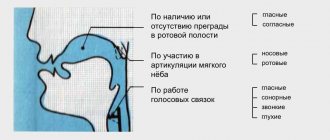Unfortunately, even parents who are not privy to medical subtleties are familiar with the opinion that a short frenulum of the tongue in a child is the cause of speech therapy problems.
Why "Unfortunately"? Because it is ignorance of the material that leads to a clear decision - the bridle needs to be trimmed! Do you remember in the film “Pokrovsky Gate” the characteristic female surgeon with her famous phrase “Cut!.. without waiting for peritonitis”? So the same thing often happens to the poor bridle. However, as experience shows, there is not always only one way out. Not every case of the so-called “short frenulum” requires radical measures.
What is a short frenulum of the tongue?
The frenulum is a thin partition that connects the tongue and the lower oral cavity. Normally, the frenulum is quite elastic, stretches well and is attached to the tongue in its middle part.
An abnormal structure may be the location of the frenulum closer to the edge of the tongue or even at its tip. In addition, a significant decrease in its elasticity, that is, its ability to stretch, is possible.
So in fact, the concept of “short bridle” is not entirely correct. Therefore, there is no clear solution to this issue.
Exercises to normalize breathing function
Exercise No. 1 Full breathing. Take a long breath through your nose. During inhalation, the abdomen “inflates”, then the chest expands. When you exhale (through the nose), on the contrary, the volume of the chest first decreases, then the stomach retracts.
Exercise No. 2 Chest breathing. Exhale. Take a long breath through your nose. At this time, the chest expands and the stomach retracts. When you exhale (through the nose), the stomach retracts.
Exercise No. 3 Abdominal breathing. Exhale. Take a long breath through your nose. At this time, the stomach protrudes. When you exhale (through the nose), the stomach retracts.
Exercise No. 4 The skill of full, extended exhalation. Walk at an average pace. Inhale and exhale only through the nose. Inhale for three steps, exhale for four steps. After three to four days, the duration of exhalation should be increased by one count (5,6, etc.)
Exercise No. 5 Inhale and exhale alternately through one nostril (press the second nostril tightly with your finger).
Exercise No. 6 Exhale. Pinch your nose with your fingers. Slowly count out loud to 5, then take a deep breath and exhale through your nose.
Exercises to strengthen the pharyngeal muscles
Exercise No. 1 Alternately tilt your head back as much as possible, leaning forward.
Exercise No. 2 Throw your head back. In this position, alternately tilt your head towards the right and left shoulder.
Exercise No. 3 Throw your head back, in this position alternately turn your head, without releasing your chin, to the right, then to the left.
What is the problem with the incorrect structure of the frenulum of the tongue?
In infants, an abnormal frenulum structure can cause difficulty sucking. In this case, the problem is solved in the maternity hospital by pruning. If the baby is still able to eat normally, doctors try to leave the situation alone, giving, as they say, time to grow. Indeed, in many cases, along with the growth of the jaw, the frenulum gradually stretches and takes on a normal shape.
In older children, a short hyoid frenulum creates some speech therapy difficulties:
- Difficulties arise with the pronunciation of hissing sounds.
- Correct reproduction of sonorants is not possible.
To pronounce the so-called upper lingual sounds, you need to raise the tip of your tongue upward. An insufficiently elastic bridle prevents this from being done.
However, it is very important to understand that it is not “responsible” for all speech problems. So if a child has a delay in speech development, syllables and sounds are “confused” in speech, a limited vocabulary or other problems, a short frenulum has nothing to do with it. The speech therapist will suggest effective methods of correction.
Exercises to normalize the function of lip closure
Exercise No. 1 Pull your lips forward, close them, draw a tube, and stretch them wide.
Exercise No. 2 Pull your lips forward, close them, depict a mouthpiece, a proboscis.
Exercise No. 3 Close your lips, puff out your cheeks, slowly squeeze the air through your clenched lips with your fists.
Exercise No. 4 Close your lips, then move them alternately to the right and left.
Exercise No. 5 Close your lips, blow air under your upper lip, then under your lower lip.
Exercise No. 6 Place bent little fingers in the corners of the mouth, do not close your lips, spread your fingers slightly to the sides, close your lips.
Exercise No. 7 Blow out a stream of air with force (“a breeze is blowing,” let’s put out the candle,” “let’s make a storm,” etc.).
How to check if a child has a short frenulum
The presence of difficulties with the frenulum can be easily determined independently:
- Open your mouth slightly and place the tip of your tongue in the area behind your upper teeth. In this position, the place of attachment of the frenulum is clearly visible. If it is not “where it needs to be,” it is difficult to lift the tongue up.
- Pull your tongue forward. A short frenulum does not allow this to be done; in addition, the tip of the tongue visually looks forked
- Open your mouth and try to touch your upper lip with your tongue and lick it. Difficulties with the bridle make this movement difficult to perform.
Please note: sometimes a child cannot cope with these exercises not because there is something wrong with the frenulum. The cause may be weak muscles of the articulatory apparatus. Take a clean handkerchief and try to help your tongue. If resistance is felt when moving, then the problem is still in the hyoid frenulum.
A set of exercises for stretching the hyoid ligament card file on speech therapy on the topic
SET OF STRETCHING EXERCISES
HYPOGLOUS LIGAMENT
Even if the frenulum is shortened (less than 8 mm), it is better to stretch it than to operate. This is supported by the fact that after the operation there will be a scar on the frenulum, which will also reduce its mobility. In addition, the operated child will be afraid to do articulation exercises for the hypoglossal ligament for a long time in order to avoid the previously experienced pain.
The short frenulum of the tongue is stretched to the required length using special exercises. If it is very short, it may take quite some time to stretch it.
Normally, the length of the frenulum is 1.5 cm. If the frenulum is shortened, the movements of the tongue are limited. Consequently, the pronunciation of sounds that require raising the tongue upward is impaired.
Rules for making sounds with a short frenulum
- Sounds that require a noticeable upward movement of the tip of the tongue (r, w, g) are placed after the child’s hyoid ligament is fully stretched.
- Sounds (l, h, sch, th, d) can be started when the frenulum has not yet fully stretched, but there is already some upward movement of the tip of the tongue.
- A short frenulum does not interfere with the normal pronunciation of other sounds of the Russian language.
Rules for performing exercises
- When performing exercises, the mouth should be opened as wide as possible, but at the same time so that the child can reach the alveoli with the tip of the tongue.
- All movements should be performed slowly, with a smile, close to the limit of what is possible.
- It should be borne in mind that performing exercises is physically difficult for a child, the tongue may get tired, the hyoid ligament may hurt - give him rest.
Exercise "Painter"
Smile, open your mouth. Using the wide tip of your tongue, stroke the palate from the teeth to the throat. The lower jaw should not move.
It's time to paint the rooms.
A painter was hired.
We lower the jaw lower,
We help the painter.
Exercise "Horse"
Smile, open your mouth. Click the tip of your tongue like a horse clicking. The mouth is open, the tip of the tongue is not extended or pointed. Make sure that it does not tuck inward and that the lower jaw remains motionless.
We're riding, we're riding a horse along a smooth path. A neighbor invited us to visit for sweet pudding. We arrived at lunchtime, but the neighbor was not at home.
Exercise "Mushroom"
Smile, open your mouth. Suck your wide tongue to the roof of your mouth. This is the cap of the mushroom, and the hyoid ligament is the stalk. The tip of the tongue should not turn up, the lips should be in a smile. If the child is unable to suck his tongue, then he can click his tongue, as in the “Horse” exercise. Clicking trains the desired movement of the tongue.
I stand on a thin leg,
I stand on a smooth leg,
Under the brown hat
With velvet lining.
Exercise "Accordion"
Position the tongue as in the “Mushroom” exercise, lips in a smile. Without lifting your tongue, open and close your mouth.
I play the harmonica, I open my mouth wider, I press my tongue to the roof of my mouth, I move my jaw lower.
Exercise "Drum"
Smile, open your mouth. Repeatedly and clearly pronounce the sound D – D – D. When pronouncing this sound, the tongue rests on the upper teeth, do not close the mouth. Very often, when performing this exercise, the child closes his mouth. To prevent this from happening, you can hold a stick about 1 cm wide or the handle of a rectangular children's toothbrush between your teeth (the handle should not be thick, it should be straight, like a ruler).
We beat the drum hard
And all together we sing:
“D—d—d—d!”
Exercise "Swing"
Smile, open your mouth. On the count of “one-two”, alternately rest your tongue on the upper and lower teeth. The lower jaw is motionless.
I swing on a swing
Up and down, up and down.
I rise higher and higher, and then down.
Exercise “Reach your nose”
Smile, open your mouth. Raise the wide tip of the tongue towards the nose and lower it towards the upper lip. Make sure that the tongue does not narrow and that the lips and lower jaw are not mobile.
Our tongue is great,
Reaches to the nose...
Exercise "Football"
Close your mouth, press the tip of your tongue against one cheek, then the other, so that balls are inflated under the cheek.
Do you want to play?
We drive the ball into the goal.
Exercise "Kitten"
Put a little condensed milk, sour cream, jam on a saucer... and lick it off with your tongue like a kitten. You can lick the ice cream with your tongue.
We poured it into a bowl
Milk for pussy.
The cat laps -
The tongue flickers.
Exercise “Self-massage”
Do the mushroom exercise. The child rubs the frenulum himself with his thumb and forefinger.
Here is a fungus on a thin stalk -
You put it in the basket!
Exercise "Mole"
Use your index fingers and thumbs to pull your tongue down by the tip.
There is a slide in the yard.
Use your index fingers and thumbs to pull your tongue upward by the tip.
There is a mink under the hill.
With your index finger, forcefully stroke the hyoid frenulum from bottom to top, stretching it.
In this hole.
The mole is guarding the mink.
Literature:
- Arkhipova E. F. Speech therapy massage for dysarthria. – M.:AST: Astrel; Vladimir: VKT, 2008
- Krause E. N. Speech therapy. (Speech therapy classes with children of early and young age) - St. Petersburg: KARO, 2005.
- Kosinova E. M. Speech therapist lessons - M.: EKSMO, 2003.
- Novikovskaya O. A. Speech gymnastics. – M.: AST; St. Petersburg Owl; Vladimir: VKT, 2008
- Polyakova M. A. Self-instruction manual on speech therapy. Universal guide. – M.: Iris-press, 2007.
Who to contact for help
Depending on the complexity of the situation, an orthodontist or speech therapist will help you cope with the problem. In any case, it makes sense to first get a consultation to decide what method of correction the child needs.
The dentist will carefully trim the frenulum, relieving the child of discomfort with one movement of his hand. However, recently doctors still recommend leaving surgical intervention as a last resort. An experienced speech therapist will offer a set of exercises and massage to stretch the frenulum.
Experts say that there are not many situations when the hyoid frenulum is absolutely unable to stretch. In almost all cases, a conservative approach achieves results.
Parents can evaluate the pros and cons of different approaches on their own.
Surgical method:
- A quick, radical solution to the problem.
- The operation is performed using anesthesia.
- The healing process takes some time and is uncomfortable.
- Dietary restrictions due to surgery.
- It is advisable to maintain vocal rest for several days.
- Psychological trauma in the child is possible.
- After the operation, classes with a speech therapist are necessary to correct sound pronunciation.
Frenum stretching method:
- Conservative, does not cause psychological difficulties in the child.
- Effective in most cases.
- Does not require changes to your usual routine.
- It takes some time (several months).
- Requires discipline and regular practice.
In any case, to resolve the issue, you need to consult a speech therapist.
Contraindications
Tongue frenuloplasty in newborns does not involve major surgical intervention, so the operation is considered safe. In addition, the procedure is painless and does not require anesthesia. However, given that after cutting a short fold of mucosa, a small wound still forms, there are temporary restrictions on manipulation related to the child’s health condition.
Temporary contraindications:
- inflammatory diseases;
- infectious diseases;
- immunodeficiency pathologies;
- acute respiratory viral or bacterial infections.
If there are contraindications for health reasons, it is advisable to postpone the operation until complete recovery.
Stages of the procedure
Trimming a short frenulum, despite the lack of complexity of the procedure, should be performed by a qualified specialist and in a medical facility. Patients do not require hospitalization. The operation takes no more than 10 minutes. Immediately after completion of the plastic surgery, the child is sent home. It is not recommended to feed the baby in the first two hours. Young children are allowed to drink water.
Stages of plastic surgery of the frenulum of the tongue.
- Preparation. The doctor asks parents for complaints, performs an examination and, if necessary, gives recommendations on preparation for the procedure.
- Operation. Administration of anesthesia, antiseptic treatment of the oral cavity, trimming of the frenulum.
In newborns, the integrity of the mucous membrane is restored in 1–3 days. The child may be restless on the first day. Difficulties with feeding cannot be ruled out, but already on the second day, babies begin to correctly take the breast or bottle nipple, which caused difficulties previously. Parents are advised to give the baby water after each feeding to avoid the accumulation of formula or milk in the mouth and the subsequent development of infection. Also, the mother must maintain breast hygiene and sterilize bottles.










